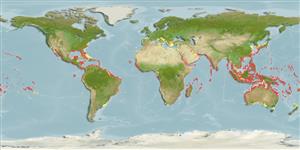Common names from other countries
Classification / Names / Names
Nomes comuns | Sinônimos | Catalog of Fishes (gen., sp.) | ITIS | CoL | WoRMS
Environment: milieu / climate zone / depth range / distribution range
Ecologia
; intervalo de profundidade 0 - 30 m (Ref. 80758). Tropical
Atlantic and Indo-Pacific oceans and the Mediterranean Sea.
Length at first maturity / Tamanho / Peso / Idade
Maturity: Lm ? range ? - ? cm
Characterized by the usually unbranched, narrow, feather-like erect branches. The pinnately arranged pinnules (ramuli) are distinctly flattened and sickle-shaped. Erect branches up to 5 cm in height (Ref. 80758).
Used as food and medicine: antifungal, to lower blood pressure (Ref. 80758). Inhabits soft to hard, sandy or rocky substrate in calm to moderately exposed habitats. Abundant in quiet waters or in tide pools. Plants of sheltered shores and in shallow water grow on sand, mud, or rocks; sometimes found in moderately exposed situations and dredged to a depth of 30 m on sand and gravel (Ref. 80758).
Guiry, M.D. and G.M. Guiry. 2009. (Ref. 80701)
Status na Lista Vermelha da IUCN (Ref. 130435)
Status no CITES (Ref. 108899)
Not Evaluated
Not Evaluated
Perigo para os humanos
Uso pelos humanos
Pescarias: espécies comerciais
| FishSource |
Ferramentas
Mais informação
Idade/TamanhoCrescimentoComprimento-pesoComprimento-comprimentoMorfologiaLarvasAbundância
Fontes da internet
Estimates based on models
Preferred temperature
(Ref.
115969): 23.3 - 29.2, mean 27.8 (based on 5331 cells).
